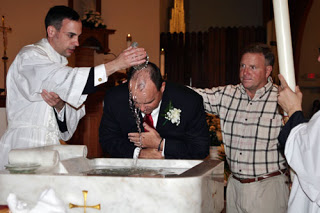CHURCH AND NOT IN THE RIVER?
Infant baptism, no doubts, am not a Catholic, however, I concord with you
having gone through the biblical justifications and analysis made. Now, am
bothered with a question and it is this: ‘Why does the Catholic Church baptize
in the Church and not in the river? It is clear that the Bible asks us to go to the river’. I
need a response. Thanks.”
bro, Christ NEVER advised us to go the river for “Christian Baptism”; he
clearly stated “water and the Holy Spirit” and later gave us the
Trinitarian formular (FATHER, SON AND THE HOLY SPIRIT).
instances where people were baptized in the Acts of the Apostles without going
to the river for immersion: “She was baptized, with her household”
(Acts 16:15). The Philippian jailer whom Paul and Silas had converted to the
faith was baptized that night along with his household. We are told that
“the same hour of the night . . . he was baptized, with all his
family” (Acts 16:33). And in his greetings to the Corinthians, Paul
recalled that, “I did baptize also the household of Stephanas” (1
Cor. 1:16). In all these cases, whole households or families were baptized, and
it is very clear from the circumstances and situations that the Apostles did
not take them to the river for immersion.
The Catholic Church and most Christian religions teach that WATER is essential
to the administration of the Sacrament of Baptism. But when it comes to the
manner in which the water should be used, there is controversy. Should it be
done by immersion, pouring or sprinkling?
In the Roman Catholic Church, most believers are baptized by pouring (also
known as infusion). At the same time, Catholics know that immersion (also known
as dunking) and sprinkling are VALID ways of baptizing. Some Protestant and
Evangelical Churches reject all form of baptism other than immersion. They
claim that most Catholics are not validly baptized. Do they have a good
argument?
to these Protestant and Evangelical Churches, the rite of baptism was always by
immersion until the Council of Ravenna in A.D. 1311, when the Catholic Church
proclaimed “Baptism is to be administered by tribe immersion or aspersion.” (“Aspersion”
means “sprinkling.”)
rite of baptism always by immersion prior to A.D. 1311? To find the answer to
this question, we turn to the “Didache”, a Syrian liturgical manual that was
written around A.D. 70 and widely circulated among the churches in the first
few centuries of Christianity. These are perhaps the earliest Christian writings
outside of the New Testament. These writings bore witness to the sacramental
practice of the Christians in the apostolic age.
In Chapter 7 of the Didache, we read, “Concerning baptism, baptize in this
manner: Having said all these things beforehand, baptize in the name of the
Father and of the Son and of the Holy Spirit in living water (that is, in
running water, as in a river). If there is no living water, baptize in other
water; and, if you are not able to use cold water, use warm. If you have
neither, pour water three times upon the head in the name of the Father, Son,
and Holy Spirit.”
These instructions of the Didache represent an established custom four decades
after the death and Resurrection of our Lord Jesus Christ, It was written while
some of the apostles were still living. It is around the same time that “The
Apocalypse of John” was written.
Turning to another source of Christian writings, Cyprian advised that no one
should be “disturbed because the sick are poured upon or sprinkled when
they receive the Lord’s grace” (Letter to a Certain Magnus 69:12 [A.D.
255]). Also, Tertullian described baptism by saying that it is done “with
so great simplicity, without pomp, without any considerable novelty of
preparation, and finally, without cost, a man is baptized in water, and amid
the utterance of some few words, is sprinkled, and then rises again, not much
(or not at all) the cleaner” (On Baptism, 2 [A.D. 203]). Obviously,
Tertullian did not consider baptism by immersion the only valid form, since he
says one is only sprinkled and thus comes up from the water “not much (or
not at all) the cleaner.”
be remembered that in the early days of the Catholic Church, many of the
believers met in the catacombs. There were no rivers of flowing water in those
tunnels. Furthermore, in view of the fact that the Christians were persecuted
during the first four hundred years, it would have been unwise for any believers
to gather in groups by the rivers and lakes in order to be baptized. As it is
out of the question to practice immersion today when someone is on their death
bed, so it was in the early days of the Church. There are many reasons as to
why immersion was frequently inconvenient.
what we have seen so far with regards to the practice of Christian baptism without
going to the river, springing from the practice of the Apostles and the early
Christians as cited above in relation with the injunction of Christ (Water and
the Holy Spirit), we understand clearly that while baptism in the river is
valid and ok, Christian baptism does not necessarily need to be carried out in
a river in order to be valid. When members of the Protestant and Evangelical
Churches claim that Catholic baptism of sprinkling is not valid, only the rite
of immersion in a river, they speak out of ignorance. If they had thoroughly
investigated the matter, they would have learned otherwise.




